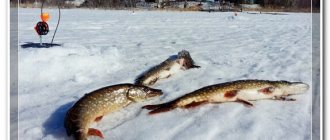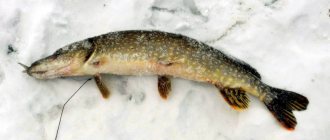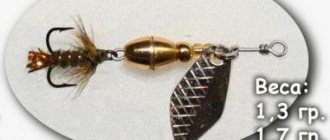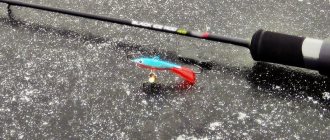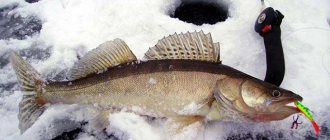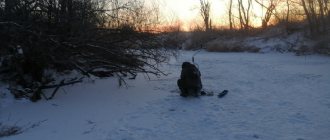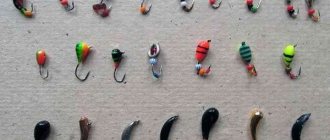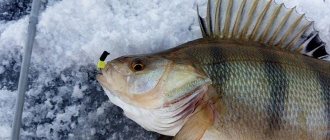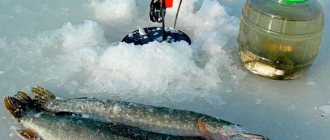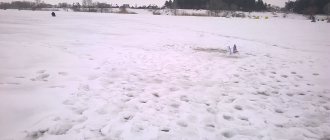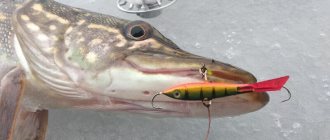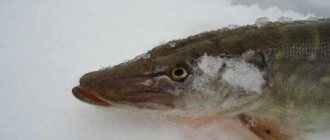Pike fishing on the first ice attracts with its excitement and prey. The toothy predator exhibits increased activity during this period, and girders are especially effective in fishing gear. To guarantee a catch, you need to know how to catch pike on the first ice, what baits are most interesting to it, and when is the best time to go hunting.
Behavior of pike on the first ice
Pike are actively caught with a spinning rod throughout the period before the ice begins to form, and during this period you need to look for it not in grassy shallow waters, as in summer, but deeper - at medium depths near the exits to thickets and shallows. The process of ice formation itself is not very important for pike - pike don’t care. For her, the location and activity of the food supply - small fish - is important.
- The spotted one does not fall into a stupor at the moment the reservoir is frozen with ice, like bream. In most cases, fishing for pike on the first ice in November and December is successful in the same places as spinning in open water two weeks earlier.
- Many resources write that active pike biting lasts no more than 7-10 days after ice formation. However, this is not a rule. It all depends on the speed of winter and freezing. As already noted, the activity of pike is primarily affected not by the ice itself, but by the movements of small fish - mainly roach, bream, and silver bream.
- In some reservoirs, during this period the toothy one actively destroys small perch and ruffe, leeches, larvae - everything that its toothy mouth can reach. There is still enough oxygen in the water, and the water temperature has not dropped to a critical level at which the pike simply cannot physically actively hunt and eat a lot.
Timing of predator activity at the beginning of freeze-up
The extinction of the pike's appetite occurs after the massive death of green vegetation under water. At the same time, everything in the reservoir seems to freeze. Microorganisms go into hibernation, the little things have nothing to eat in the old places - they move deeper, to wintering areas. Following the schools of forage fish, the pike also leaves.
The oxygen level and water temperature drop - all the inhabitants of the reservoir enter winter energy saving mode. The pike is already located somewhere near the small fish parking lot. Because he can no longer go on long-distance raids.
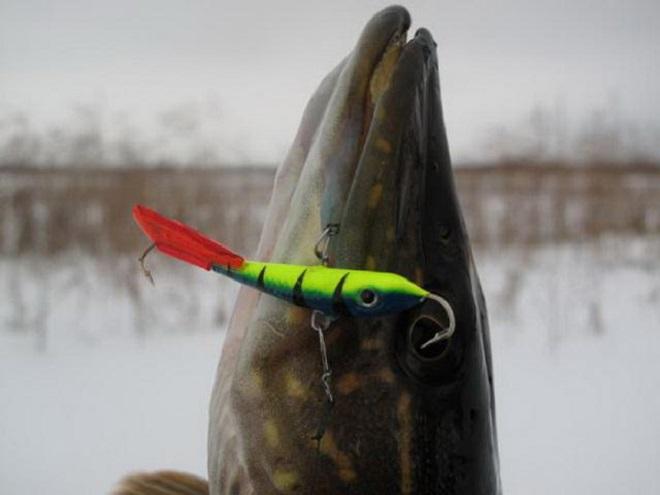
This is what distinguishes the behavior of pike on the first ice from that later, throughout the winter. In the first ice, the predator crosses considerable distances when exiting – tens of meters. In the dead of winter, she will not go further than a few meters from her ambush. Therefore, in the first ice, some mistakes in choosing a place are acceptable - an active pike will most likely find bait if it is somewhere nearby. During the remaining periods of winter, you need to get into the predator’s hunting zone with an accuracy of several meters.
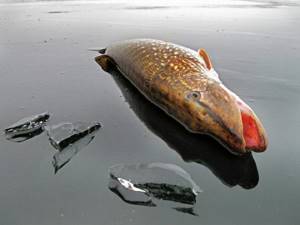
Important points
If the autumn turns out to be long, the ice rises and falls, then by the time a solid cover is formed that you can go out onto, the pike has already occupied winter quarters. You can catch it, but not on the coastal edges, but at winter mooring points. And this will be ordinary fishing for pike in winter from the ice, and not fishing on the first ice.
The first ice rules work in normal seasons, when winter comes into its own according to the schedule, as it should be in a particular region. This is especially evident in the southern regions, where ice sometimes appears only in January.
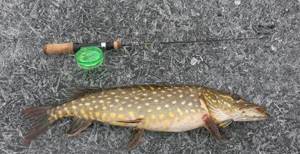
By that time, the vegetation in the water has already begun to rot, and small fish and pike move deeper. If the first ice rises as expected, right away, in November-December, then in the first week or two after that you can successfully catch toothfish in the coastal grass, even at depths of 30-50 cm, at the exits of shallow bays, as in the summer. During outings, large deep-sea pike can also visit here, which will happily catch and eat a gaping smaller pike.
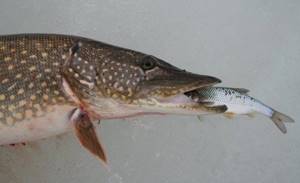
Pike hatches and biting times on first ice
At the peak of activity, the pike feeds all day, filling its belly. When this period coincides with the moment when it is already possible to go out on the ice, you end up eating pike on the first ice. Then, as the weather gets colder and the ice cover grows, the pike’s schedule becomes more and more fragmented, outings happen less and less often, and the spotted one begins to hunt at certain hours.
Even with the first ice on most reservoirs, a certain schedule of predator exits is observed. It may be only a couple of hours from the time it is in full bloom until lunchtime, as well as after.
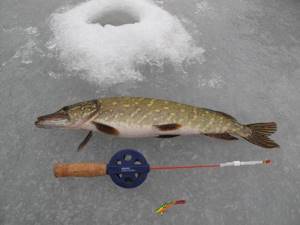
Each body of water has its own time for such exits. At such moments, the flags of the girders begin to fly up simultaneously at all points, while at others there is absolute silence, the predator stands. Therefore, if the time of exits is known, then during periods of activity it is reasonable to fish with girders, and during periods of calm, actively search with a spinner, a balancer or a winter wobbler. If you throw bait under the nose of a standing predator during the first ice, it will most likely grab it, even if its belly is already full of food.
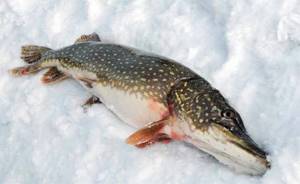
Tips for advanced anglers
Fishing for pike on the edges
If you catch pike on the edges, then keep live bait at a depth of 10-50 cm from the bottom.
If fishing in a riverbed, the depth can be halved.
What to do if the slope is shallow?
If the slope is gentle, then let the bait fish sink to the depth, it is better if you know the depth and location of the holes, if not, you will have to probe the bottom experimentally.
Watch the video: Catching pike on a girder in winter
Fishing for pike in winter is exciting and will give you a lot of pleasure. However, you need to study the behavior of fish, fishing techniques and tactics, take into account weather conditions, choose the right place and the right equipment and girder, and then you will be rewarded with a great catch.
Where to look for pike on first ice
At the beginning of freeze-up, depending on the reservoir, the spotted huntress can cruise both in shallow water and in the adjacent depths.
- In small bodies of water with an abundance of vegetation without vast clear water areas with depths, the pike stands on the first ice at the edge of the thickets or right in the reeds. Local holes, snags and bays are also promising.
- In vast water areas without obvious relief anomalies, the toothy fish will be located at a certain depth level. A 10 cm groove, micro-differences, and a separate log are the only options for an ambush. On such reservoirs, you can navigate by other anglers who are fishing with jigs. If small roach, perch, silver bream or white bream are present in the catches, then a spotted one is somewhere nearby.
- On ordinary rivers and reservoirs with pronounced dumps, edges and beds, we look along these anomalies. Depending on the speed of the onset of winter, pike can hunt both in the upper part of the edge and below. Standard pike places are also promising - local holes, bays, gullies, snags, underwater spits and islands of thickets. All November spinning spots are open.
- In quarries and lakes, you need to catch pike on the first ice in the same way as in large flowing ponds and reservoirs. It is necessary to find places where small and medium depths border on large ones, as well as local relief anomalies. The standard search area is the edge of reed thickets, beyond which the pronounced edge goes downhill.
- On reservoirs with complex terrain, we examine standard pike places - flooded trees, depths next to a wall of reeds, entrances and exits from ponds, mouths of streams and small rivers, turns of the riverbed, quiet areas behind a cape, grassy exits from holes and pools.
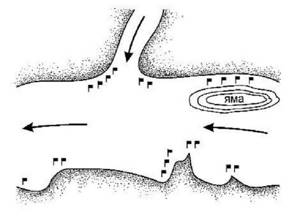
Fishing technique
Follow the instructions:
- Choose a location;
- Hook up some live bait;
- Launch it into the water;
- Secure the girder, tighten the fishing line and secure the alarm.
The alarm is adjusted so that at the moment of a bite it indicates this, but so that it does not react to the twitching of live bait. After completing the adjustments, just wait for the bite. As soon as the alarm goes up, hook it. After hooking, pull it out of the hole. If the hole is too small and the fish does not fit into it, release the fish a little and drill your hole, after which you can safely pull out the predator.
Sometimes the pike hooks itself, since it doesn’t feel much resistance, which means it freely swallows the bait.
If the pike does not bite, but you are sure that it is in this area, then feed this place with store-bought or homemade bait or winter bite activators .
Choosing a fishing spot
Places near snags are a good place to look for pike.
In winter, it is best to fish in familiar areas, where the fishing sites are probably known. Otherwise, the chances of success are reduced. But don't despair, there are universal tips.
It is best to look for pike near snags, near the coastline near thickets of reeds or reeds.
The bulk of fish after the first ice is in shallow water. These are mainly depths from 40 to 60 centimeters. Later, when the ice crust becomes thicker, the fish move to deep water. At this time, it is best to catch pike in the edges and flooded ravines.
It often happens that at great depths zones poor in oxygen are formed, which indicates that there will be no fish in them. If it is noticed that the baitfish is dying quickly, then it probably falls into such a zone. In such cases, fish at half-water.
A very promising place for fishing will be the transitions between pits. In such places, pike will be caught throughout the season.
Installation of the vent
After choosing a location, we begin installation.
The first pike exits start at 8:30, therefore, the lures should be in position by this time. The main thing is not to make too much noise while drilling holes, otherwise you can scare away all the fish. Install some of the vents in shallow water, and some in deep water. Thus, you can “test” the reservoir for the presence of pike.
It is important to remember that any place cannot be unpromising. If you know the bottom of the reservoir and the choice of location is on a slope, then you need to place it both in the upper part of the slope and in the lower part. On lakes and ponds, girders are usually placed along the shore, not far from thickets of coastal grass.
The vents are usually installed at a distance of 6-8 meters from each other. The order of placement will not matter.
Instructions:
The bait must first be installed on the bottom of the reservoir, and only if the live bait often dies, fishing should be carried out at half-water. To check the depth, lower the fishing line and sinker installed on the rig into the water until the sinker touches the bottom. And remember that below the sinker is a leash. This means that it is important to wind the reel to the length of the leash. This length of the fishing line will be the depth of the reservoir in the selected location. After checking, you can attach live bait, if there is one, or go after it to catch it.
Important: after attaching the bait, screw the reel 2-3 turns to keep the bait above the underwater vegetation and it cannot tangle the fishing line, or simply hide from the pike.
On warm days, or with the onset of thaws, or during low pressure, the pike usually rises to the middle of the reservoir or to its very top. It will be especially productive to place live bait in mid-water at lunchtime.
If, since the girder was recorded, there have been no bites over the next 1-2 hours, then the girders are moved to a neighboring place 20-25 meters from the previous fishing spot. If in one of the places the pike began to take live bait, then next to it, 2-3 meters away, you can drill another hole and set the same depth.
If pike fishing is carried out in very cold weather and the trap is not equipped with a flat base, then it is necessary to cover the hole to prevent it from freezing. This can be done using cardboard, paper, a piece of plywood or any other material that can cover the hole hole. If you don’t have anything at hand, you can sprinkle the hole with snow.
It will not be superfluous to cover the hole in normal sunny weather, without severe cold, so that the pike is not frightened by the light rays passing through the holes.
Features of hooking and fishing
There are several aspects to successfully hooking and landing a pike. Don’t do the hooking right away , give the pike a little time to swallow the bait, otherwise when you try to hook the pike, the pike may open its mouth and the hook will freely come out of it.
After successfully hooking, keep the line tight, but not too tight. If you give up the slack, the pike can go into the grass or snags, and as a result, the line can get tangled. If the tension of the line is too strong, you can break the line, firstly on the sharp teeth of the pike, and secondly on the edge of the ice in the hole. It is worth remembering that fishing is done with your fingers.
Pike up to 1.5 kilograms can be pulled out immediately, as it will not offer much resistance. When bringing the pike to the hole, the beam will use a hook. If this is not the case, then you can gradually, either release or drag the pike to the hole. After 4-5 such manipulations, the pike will enter the hole itself.
There is one trick in fishing for pike: when you feel that the pike is large and there is a high possibility that it will bite the fishing line, just let go of the fish a little, not allowing the fishing line to weaken, and then smoothly slow down the fish by pulling the fishing line toward you. Thus, the fishing line, being on the edge of the mouth, closer to the body, will catch on the so-called “whisker” and after that the pike can be pulled towards you without fear that it will rub its teeth on the fishing line. And the pike moves easier - it makes fewer strikes.
Tactics and technique
Fishing for pike on first ice in an unfamiliar body of water first of all involves searching for promising places. Further - depending on the conditions of the reservoir. In water areas with pronounced anomalies, we fish for promising points; on a homogeneous terrain, we look for a certain level of depth, punching holes with artificial baits or moving supplies. If there are several fishing trips ahead, it is important to time the exits when they occur.
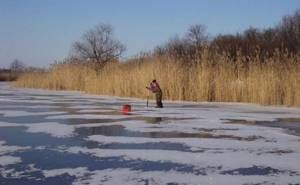
In the following days, with the same weather, such periods of biting will most likely be repeated. Therefore, on the next fishing trip at promising points, by the time the bite starts, the girders should already be loaded, or the holes for trolling should be drilled.
Drilling ahead of time is especially important in shallow waters. After all, the exit can last only an hour, and you shouldn’t take half of such a short time so that the fish calms down after drilling the hole. At the moment of a short exit, we just walk and catch - because soon this period will end.
The peculiarity of catching pike on the first ice is the transparency of the ice shell and fishing in relatively shallow water. Therefore, especially on a sunny day, it is important to maintain camouflage, otherwise you may not get a bite.
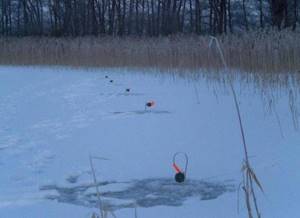
Disguise
Pike have excellent eyesight, and the shadow of a fisherman on a sunny day in shallow water frightens it. When drilling holes, at the final stage of drilling, you need to slowly pump out a little water onto the ice with an auger. When it freezes, the shell will become slightly dull and the transparency will decrease.
- When fishing for pike on the first ice, in principle, you need to be careful and quiet - do not run with long strides towards the poles, do not knock on the ice with a drill, slotted spoon or box. It is also better not to move the sled - on ice without snow, they rumble like an old truck over potholes.
- This is noticeable when fishing with girders - after operation, the reel stands still, and begins to spin only at the moment the angler, rushing at full speed, approaches the raised flag, when the pike leaves, having heard the noise and felt the vibrations of the water from the sagging ice along the side line.
- Therefore, you need to move on the ice carefully, not rush like a heffalump, but glide as if on skates, with shuffling movements, without lifting your legs from the surface if possible. When flashing, it’s also better not to fuss - everything is done measuredly, slowly.
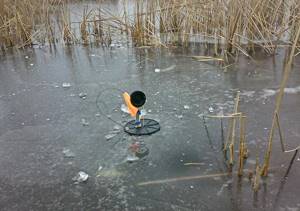
Fishing methods
For fishing for pike on the first ice, girders and vertical lures are mainly used, less often - fishing with live bait using winter fishing rods or ice bottoms. Catching pike on the first ice with live bait is more often practiced simply for fun, together with fishing for peaceful fish with a jig or fishing rod. At the beginning of the freeze-up, not only pike, but also peaceful fish are caught well.
Just like in the summer, it’s a good idea to protect the point from the toothy fish and catch it so that it doesn’t interfere with fishing for roach or crucian carp, just like in the summer. However, to do this, you can also place a couple of flags nearby, using the caught small items as bait.
Article about fishing on first ice
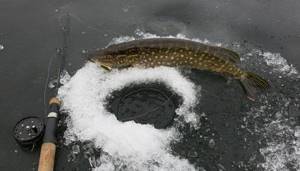
If the purpose of fishing is specifically for pike, then it is better to use flags or lures. A good practice is combined fishing with lures and lures. The girders are placed at obvious points by the time the pike comes out. During periods of rest, the angler is actively looking for new promising areas with a spoon or balancer.
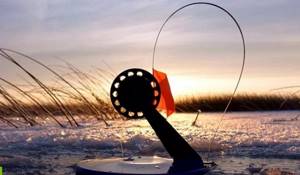
Features of fishing
Once the hooking has been completed, there is no need to rush into retrieving. It would be a mistake if, when fishing, you start to wind the fishing line around your hand; the pike can jerk sharply and if you don’t let it go in a timely manner, it can break the main fishing line that is installed on the tackle.
With extreme caution, you should bring the pike into the hole; it should clearly follow the fishing line; as soon as the muzzle appears in the hole, a hook is used, which is inserted under the fish’s gills.
I recommend to read:
Grayling in autumn - tips and tricks
First ice on November 4th

Share with your friends!
Zherlitsy
Fishing on the first ice for pike with flags is a classic of the genre. Many predator hunters with girders look forward to the period of ice formation for the sake of such fishing. However, despite the activity of the predator and the relative simplicity of the gear, fishing with girdles requires a special approach. This is a whole system of preparatory and tactical actions. And the equipment for flags can be made in several versions.
The fishing method of fishing for pike on the first ice is successful when all the components of such fishing are thought out and executed in advance - the right bait is caught, the place is strategically chosen. Usually pike are caught using flags during daylight hours. However, on some reservoirs, stands left overnight also work well. Article about fishing with girders on the first ice:
https://podlednik.ru/lovlya_zimoj/zherlicy/rybalka-na-zherlicy-po-pervomu-ldu
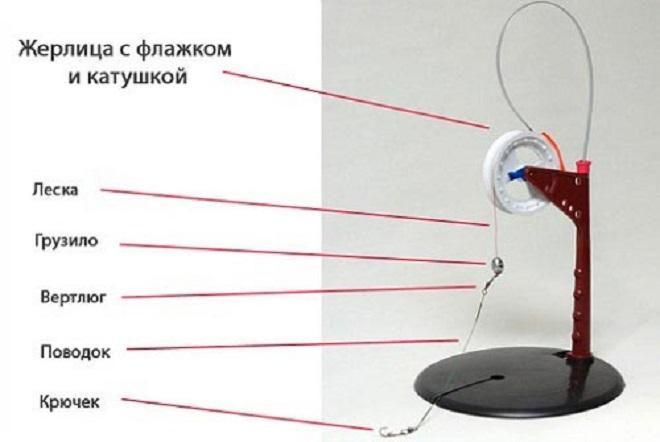
In grassy areas, the traps are placed so that the bait does not get entangled in the grass. The rig needs to be measured so that the fish is above the cluttered bottom and does not pull the rig into a cramp. In the snags, the length of the reel's descent is thought out so that the pike that takes it does not lead into the wilds. In some cases, equipment is installed based on monofilament fishing line about 3 mm, in others it is better to use fishing line 0.45-0.6 mm.
Some fishermen use metal leashes, others use transparent ones, made of fluorocarbon, and others use soft ones, made of braided braids or special leader material. It is not only the installation point that matters, but the height at which the bait fish rises above the bottom. It may vary depending on conditions. Zherlitsy is a whole science in which there are no trifles, and every nuance affects the effectiveness of fishing. More information about fishing for pike with girders on the first ice:
https://podlednik.ru/lovlya_zimoj/zherlicy/shhuka-na-zherlicu-po-pervomu-ldu
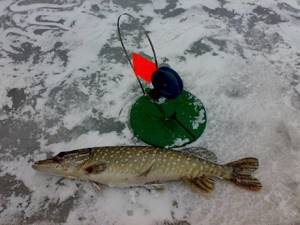
Subtleties of fishing with girders
For pike hunting on the first ice, girders are very popular. The gear is relatively simple, but highly effective.
Features of gear, varieties
There are many modifications, but all have the same equipment. Among the main tasks that the design of winter gear must perform are:
- Do not interfere with the free passage of the fishing line while unwinding it when hooking a predator. But at the same time, the bait, when moving underwater, should not pull out the line and contribute to its unwinding.
- Informing the fisherman about the bite.
- The tackle must be in a stable position in all weather conditions.
- Do not cause discomfort during operation, installation and transportation.
There is a huge range of winter girders on the market. Often fishermen make flags with their own hands and modernize ready-made models. At its core, a winter fishing line is a reel of fishing line that is fixed in a stable position. After the bite, the pike easily releases the attached equipment and heads to the side when grabbing the bait. The angler will know about a bite thanks to a spring or pendulum element with a flag; instead of it, any other bright detail, clearly visible from a long distance, can be used. When a predator attacks live bait, this element is released or rises, controlling the unwinding.
On the platform
The basis of the tackle is a plastic, metal or wooden plane, which is placed on top of the hole. To prevent it from freezing, they provide protection. In the plane there is a slot for passing the scaffolding and a mount with a reel and a flag. This flag is installed on a steel spring, which during installation begins to bend and rests against the reel, preventing the thread from unwinding under the influence of the force of the current, the weight and movements of the bait with the sinker. The tackle is activated by a jerk of the predator, the flag rises, the reel is released, and the line begins to come off. This type of girder is in great demand; the main thing is to make sure of the quality of the plastic when purchasing, otherwise the fragile product may be destroyed or damaged when exposed to low temperatures.
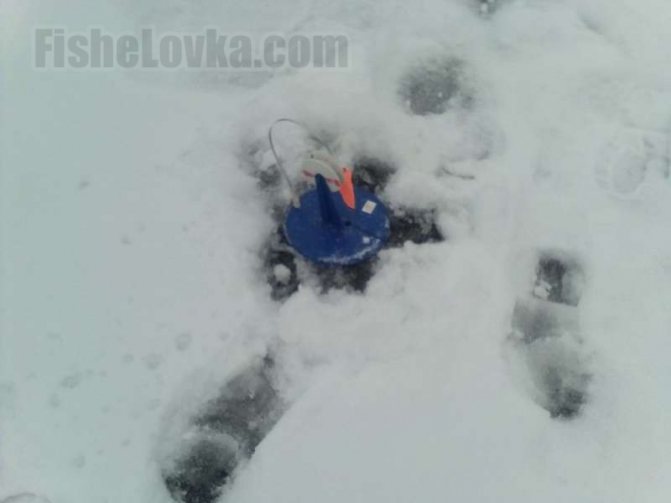
Photo 2. Regular store rack.
On the crossbar
These models are made on a tube, rail, board. This design option is about 30 cm in length. The rack with a reel and a flag is fixed in working position between two brackets by a loop of fishing line. This is gear that you make with your own hands. But they are ineffective, they are not equipped with a reel, and the supply of thread for unwinding must be laid out on the ice, where it often gets tangled and frozen. Due to unreliable fastening, the flag may operate idle. Such horizontal versions work well as stands if the frost is mild.
There are American fishing rods designed on a similar principle; they have a line spool, which is under water in the working position. Thanks to this design, pike fishing is much more active. But its disadvantage is its high cost. In addition, complex tackle, if left on the hole for a long time, will be covered with snow; it does not have a protective screen against freezing.
Other models
These include fishing rods on a tripod, a peg, hatchets, and shifters. All of these zherlits have weaknesses that the above-described varieties do not have. And the main drawback is the instability in the working position. If there is no snow, then there is also no way to stick a peg into the ice, and the upside-down crosspieces and tripods tip over when exposed to the wind.
Choice of live bait
To provoke the toothy predator to attack, you will need live bait. It is better to use the one that is found in a particular body of water. Among the catchable options for pike bait are the following:
- roach fry;
- small perch;
- crucian carp;
- minnow fry;
- dace;
- ruff;
- small bulls.
Important! Roach is not stored for a long time; other live bait can be used even after a week. The main thing is to store it in the refrigerator.
Beef liver that is not frozen is highly effective. It is attached to a single hook.
Tactics and techniques of fishing with girders
The success of fishing with girders on the first ice largely depends on the correct installation of equipment and the choice of a promising location. Also, a good reaction will allow you to react quickly and make a confident hook with landing.
There are certain recommendations to increase your chances of catching pike on ice strips:
- The line must be strictly perpendicular to the water, without any deviations from the hole.
- It is worth placing live bait at a height of 50-70 cm from the bottom.
- The catch of live bait should be carried out in the same body of water where the hunt is planned. It should be a fish with increased vitality.
- There is no need to travel long distances; the predator lives near the sites of forage fish.
- You should be on the ice in compliance with the rules of camouflage, without creating unnecessary noise or fuss.
- If you have two leashes on the tackle, you should use different live baits.
- When hunting in strong currents, the weight must be made heavier.
- If the gear is installed at night, it is recommended to sprinkle it with snow.
Among the main tips, including where to look for pike, are:
- To make the process easier and more comfortable, an echo sounder is used.
- The amount of catch directly depends on the number of gears. But according to the law, their number should not exceed 10 pieces.
- First of all, you should catch snags, where the predator waits for its prey.
- If there are no bites for a long time, the fishing spot should be changed. You also need to check for the presence of live bait.
- To check the hole, it is recommended to use a hook or an extractor to remove prey from the hook.
The selection of equipment must correspond to the dimensions of the predator in order to prevent the line from breaking or leaving if danger is detected.
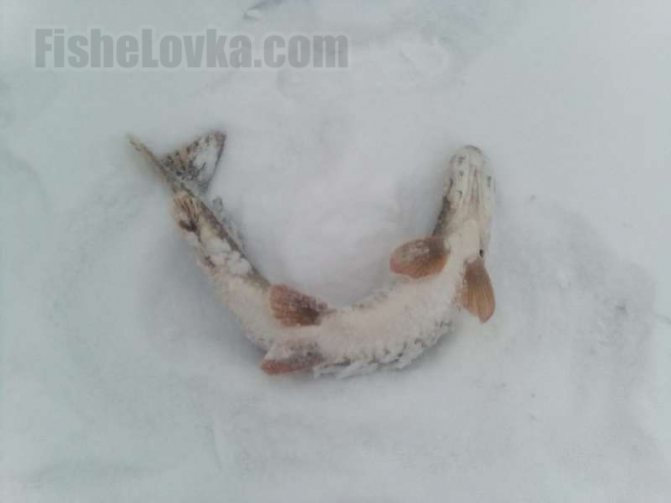
Photo 3. Freshly caught pike on snowy ice.
Winter sparkle
The pike bite on the first ice, despite the seasonal peak of activity, is not constant. At one time it is better to take on live fish, in other conditions - on artificial bait. In addition to girders, you can successfully catch toothy fish during this period using vertical lures. For this, standard winter baits are used - spoons, balancers or ratlins.
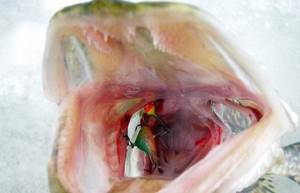
Spoons
The good old spinner often shows itself in skillful hands better than newfangled balancers and ratlins. Typically, an angler uses one medium or powerful caliber tackle, adjusted to a certain weight of the bait. During the experiment, any bait, including balancers and winter wobblers, is suspended on one fishing rod on a 0.25-0.3 mm fishing line with a leash.
Unlike pike perch, pike prefers a gliding and slow game, with long pauses of about 10 seconds at the bottom fishing point. Not only winter vertical lures work for pike, but also regular summer oscillating lures, since they have just the right game during the vertical retrieve. These are wobbler or atom shaped pieces of iron familiar to all spinning anglers. When playing, they deviate far to the side and plan downward, making oscillatory movements. More information about winter lures for pike:
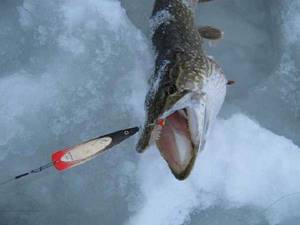
Balancers
In the first ice conditions, balancers of medium and large sizes also work toothily. During this period, balancers of bright, provocative colors - crimson, orange or perch - perform well. However, on some reservoirs the toothy fish takes only neutral and natural colors of bait. Pike requires a special game, different from the uniform perch or zander oscillations and twitches. Read more about fishing for pike on first ice using balancers and spinners
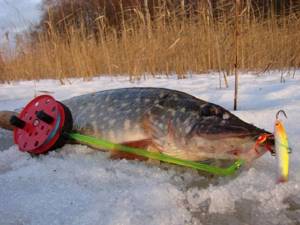
Ratlins
The latest newfangled volumetric lures - ratlins (vibes), which are essentially winter wobblers, also perform well. However, not all models work on pike from ice. To fish with vibes, you need to understand the intricacies of wiring and types of baits. Each vibe requires an individual approach and its own style of fishing. Once mastered, fishing with ratlins helps out when other baits don’t work. Article about catching pike with rattlins:
https://podlednik.ru/lovlya_zimoj/khishhniki/shhuka-na-ratliny
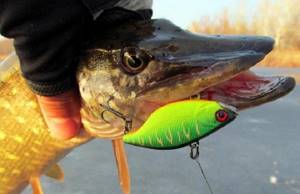
How to bait live bait
We’ll look at how to select and plant live bait below.

Basically, 3 methods of attaching live bait are used:
- Through the operculum;
- Through the back;
- For the lip.
Through the gills
A leash is inserted through the gills of the baitfish so that the hook comes out of the mouth. And the leash comes out under the gill cover.
The pike swallows the bait and calmly swims away, and once it feels the fishing line, it will no longer be able to spit out the bait and stays firmly on the hook. This method is suitable if you leave the bait overnight, but you need to make a longer leash; the pike will cope with the fishing line and have a bite.
We bait live bait through the back
- Between the baitfish's upper body and the spine, this method allows the baitfish to stay alive longer.
- Under the spine.
You need to bait this method more carefully, as you can damage the nerves of the spine and the bait will quickly become immobile.
By the lip
- With light weight tackle and a single hook, use the hooking method - by the lip.
- If there is a strong current, go behind the lower lip; if there is a weak current, go behind both lips.
Watch the video: How to attach live bait for winter pike fishing on girders
Weather influence
The first ice does not mean widespread and constant toothy gorging. Pike bite on the first ice with varying intensity, depending on the characteristics of the reservoir and the weather. In some places it is caught all day, in others - at a strictly defined time. The weather also influences the predator’s exit and rest cycles. In one body of water in different weather, the behavior of pike may differ.
Standard normal conditions are equal air pressure, a calm cloudy day or partly cloudy skies. On a bright sunny day, pike will most likely go hunting in the morning or evening. On cloudy days, she usually feeds evenly throughout the daylight hours.
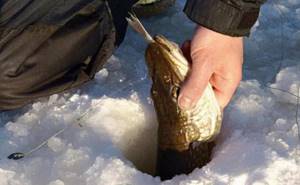
It's good if a little snow falls. A thin cover on the ice will hide the fisherman and his shadow from the watchful gaze of the spotted hunter. It is important that there are no sudden weather changes, severe frost or gusty winds that rock the thin ice. The phases of the moon influence the bite of pike to a greater extent than other fish. This is due to the structure of her vestibular apparatus. During the full moon, this fish is usually inactive. Read more about biting pike from ice in different weather.
